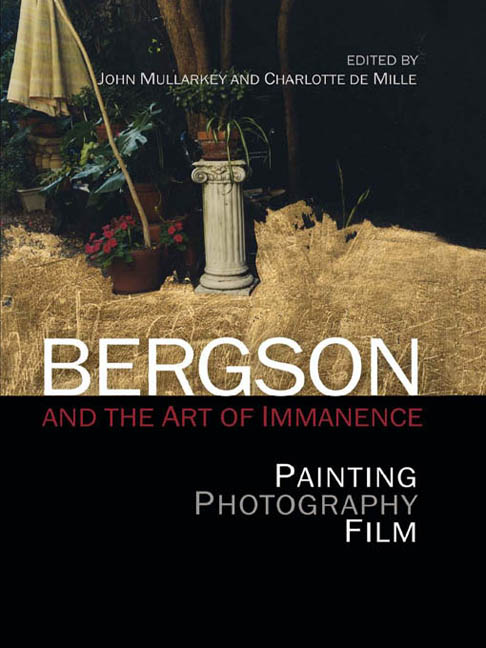Book contents
- Frontmatter
- Contents
- List of Illustrations
- Notes on Contributors
- Introduction: Art's Philosophy – Bergson and Immanence
- Part I Bergson, Art, History
- 1 Bergson, History and Ontology
- 2 Art History, Immanently
- 3 Art History, Less Its Conditions of Possibility: Following Bergson's ‘Le Possible et le réel’
- 4 Matisse, Bergson, Oiticica, etc.
- 5 Bergson Before Deleuze: How to Read Informel Painting
- 6 Revolutionary Immanence: Bergson Among the Anarchists
- Part II Unconditional Practice
- Part III Immanence of the Visible
- Afterword: An Art Historical Return to Bergson
- Index
6 - Revolutionary Immanence: Bergson Among the Anarchists
from Part I - Bergson, Art, History
Published online by Cambridge University Press: 07 December 2017
- Frontmatter
- Contents
- List of Illustrations
- Notes on Contributors
- Introduction: Art's Philosophy – Bergson and Immanence
- Part I Bergson, Art, History
- 1 Bergson, History and Ontology
- 2 Art History, Immanently
- 3 Art History, Less Its Conditions of Possibility: Following Bergson's ‘Le Possible et le réel’
- 4 Matisse, Bergson, Oiticica, etc.
- 5 Bergson Before Deleuze: How to Read Informel Painting
- 6 Revolutionary Immanence: Bergson Among the Anarchists
- Part II Unconditional Practice
- Part III Immanence of the Visible
- Afterword: An Art Historical Return to Bergson
- Index
Summary
In 1913 a public battle occurred among prominent figures in the anarchist movement over the merits of Henri Bergson. This heated exchange pitted the defenders of anarchist-communism – led by the prominent Russian anarchist and scientist Peter Kropotkin (1842–1921) and his ally Jean Grave, editor of Les Temps Nouveaux (1895–1921) – against a group of anarchist individualists headed by Andre Colomer (1886– 1931), co-founder of the journal L'ction d'art (1913). At the time, Kropotkin was an international celebrity among the European intelligentsia, whereas Colomer was a self-styled philosopher, poet, theatrical performer and rising star in the anarchist firmament. This schism also implicated prominent avant-gardists like the Neo-Impressionist Paul Signac who drew on Kroptokin and Grave's scientific metaphors in proclaiming the anarchist import of his artistic technique, and a younger generation of symbolists and Futurists who participated in the Action d'art project and shared Colomer's enthusiasm for Bergson's metaphysics.
Kropotkin and Colomer's contentious struggle to define anarchism's epistemological foundations surprisingly dovetailed with another heated debate over Colomer's decision to publically defend the illegal activities of a group of bank robbers known as the ‘Bonnot Gang’, whose notoriety reached a crescendo during a well-publicised trial that lasted from February to April 1913. From February to December of that year, Colomer proclaimed his allegiance to Bonnot in the pages of L'ction d'art in a series provocatively titled ‘From Bergson to Bonnot’ and ‘From Bergson to Banditism’. Colomer's campaign was based on a synthesis of Bergson's thought with that of Max Stirner, whose book Der Einzige und sein Eigentum (1844) was foundational for the anarchist individualist movement. Thus when L'ction d'art announced the creation of a bookstore at its headquarters in the heart of the Latin quarter (25 rue Tournefort), Stirner's manifesto, translated as l'nique et sa propriété in 1899, was advertised alongside Bergson's Time and Free Will (1889), Matter and Memory (1896) and Laughter (1900) under the heading ‘Philosophy-Aesthetics-Combat’.
- Type
- Chapter
- Information
- Bergson and the Art of ImmanencePainting, Photography, Film, Performance, pp. 94 - 112Publisher: Edinburgh University PressPrint publication year: 2013



